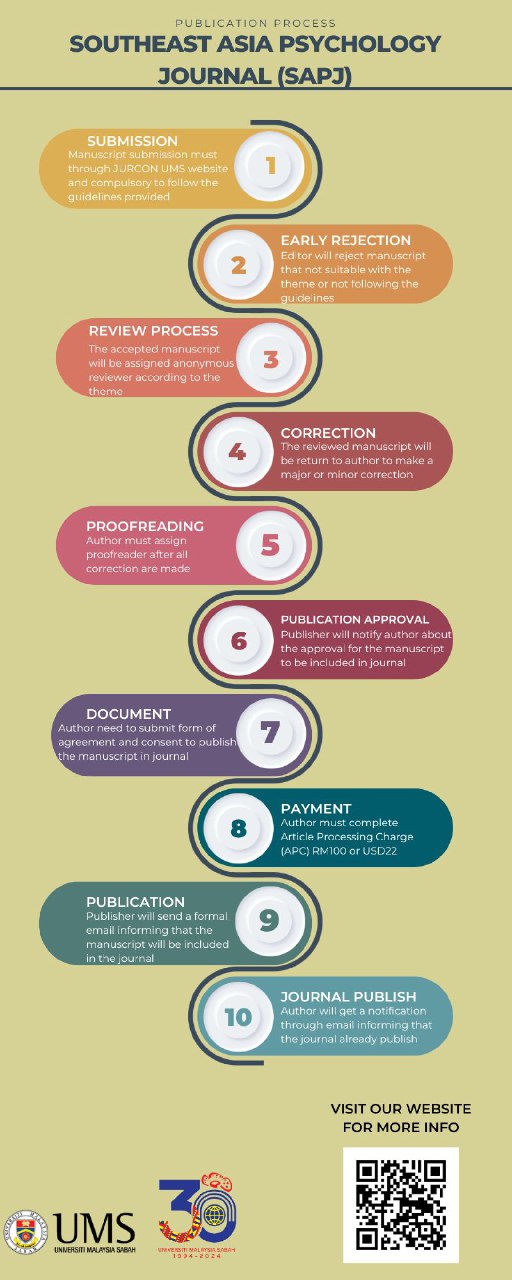ENGLISH SPEAKING ANXIETY OF CHINESE MIDDLE SCHOOL STUDENTS: A PERSPECTIVE BASED ON STUDENTS’ PERSONALITY DIFFERENCES
DOI:
https://doi.org/10.51200/sapj.v12i1.5057Keywords:
Type, Speaking Anxiety, FLCASAbstract
This study aims to investigate the difference in English-speaking anxiety levels with different personality types among middle school students, employing a one-way analysis of variance (ANOVA). The participants comprised third-grade middle school students in Jinjiang District, Chengdu, China, with a sample size of 370 students. Two instrumental tests, namely the personality type test and the English-speaking anxiety level test, were conducted for data analysis. The E-scale of the Eysenck Personality Questionnaire (EPQ) was used to determine students' personality types, while the Foreign Language Classroom Anxiety Scale (FLCAS) questionnaire assessed their anxiety levels. The results revealed a significant difference in the level of English-speaking anxiety between introverted and extroverted students, F(4,365) = 5.363, p < .05. The English-speaking anxiety of introverted students is lower than that of extroverted students. Based on the characteristics of students' personalities, it is recommended that educators adopt instructional approaches such as promoting cooperative learning, providing moderate error correction, offering moderate attention to students, and enhancing guidance on learning strategies to mitigate
speaking anxiety in students. However, it is crucial to note that the study's scope is confined to middle schools in Jinjiang District, limiting its applicability to students in other regions of China.
References
Alagić, M. (2022). Extroversion and introversion in Second Language acquisition. MAP Education and Humanities, 2(2), 22-29.
Al Noor, H., & Khan, M. E. I. (2019). Effects of personality and motivation in second language acquisition: a tentative study on adult ESL learners. EPRA International Journal of Research and Development, 4(10), 53-59.
Aniq, M. (2021). Student’s oral participation of speaking class: a case study of extroverted and introverted students (Doctoral dissertation, Universitas Islam Negeri).
Aydın, O. T. (2020). Social Interaction Between Students: Local and International Students' Experiences at a Turkish University. Journal of International Students, 10(2).
Cao, N. N. (2022). Study on the correlation between self-concept of spoken English and oral anxiety in non-foreign language majors (Master's Thesis, Huaibei Normal University).China National Knowledge Infrastructure.
Chang, H. J., & Wen, B. S. (1994). The distribution of an actual sample size increment in stratified random sampling. Communications in Statistics-Theory and Methods, 23(6), 1735-1742.
Chen, M. (2019). A study on the current situation and intervention of middle school students' anxiety in oral English learning (Master's thesis, Nanjing Normal University).China National Knowledge Infrastructure.
Chen, Y. X. (2020). How to overcome oral English anxiety. English Teachers, (4), 20-21.
Chen, Z. G. (1983). Item analysis of the Eysenck personality questionnaire. Psychologist, (2), 211-218.
Dai, J. L. (2021). Effect of foreign language anxiety and personality traits on candidates' oral English performance (Master's Thesis, Sichuan International Studies University).China National Knowledge Internet.
Dornyei, Z. (2005). The psychology of the language learner: Individual differences in second language acquisition. New Jersey: Mahwah.
Dornyei, Z., & Ryan, S. (2015). The psychology of the language learner revisited. Routledge.
Ellis, R. (1994). The study of second language acquisition. Shanghai: Shanghai Foreign Language Education Press.
Eysenck, H. J. (1967). The biological basis of personality. Springfield: Thomas.
Gong, Y. X. (1984). The revision of Eysenck personality questionnaire in China. The Psychological Science Newsletter, (4), 13-20.
Guo, W., & Wu, W. S. (2008). Test of the foreign language classroom anxiety scale (FLCAS) in some primary and middle school students. Journal of Yichun College, (2), 185-189.
Guo, Y. X. (2021). A Survey study on English classroom speaking anxiety of junior high school students (Master's Thesis, Inner Mongolia Normal University).China National Knowledge Internet.
Horwitz, E. K., Horwitz, M., & Cope, J. (1986). Foreign language classroom anxiety. Modern Language Journal, 70(2), 125-132.
Hou, Q. Y. (2012). A Study on the Relationship between Personality Dispositions and English Learning Anxiety in Junior High School Students (Master's thesis, Harbin Normal University).China National Knowledge Infrastructure.
Huang, Y. H. (2021). A study of teachers' error correction behaviour and students' needs in junior high school English classrooms (Master's thesis, Central China Normal University).China National Knowledge Infrastructure.
Husain, B., Basri, M., Martora, J., Sibua, A., & Gogasa, I. (2020). Personality Type Tendency Toward Students’speaking
Anxiety. Jurnal IKA PGSD (Ikatan Alumni PGSD) UNARS, 8(1), 57-67.
Jin, B. (2022). Study on the Current Situation of English Learning Anxiety of Rural Elementary School Students and Its
Countermeasures (Master's thesis, Yanbian University).China National Knowledge Infrastructure.
Jung, C. G. (1913). The theory of psychoanalysis. The Psychoanalytic Review (1913-1957), 1, 1.
Khalil, R. (2016). Influence of extroversion and introversion on decision making ability. International Journal of Research in Medical Sciences, 4(5), 1534-1538.
Krejcie, R. V., & Morgan, D. W. (1970). Determining sample size for research activities. Educational and psychological
measurement, 30(3), 607-610.
Liu, Q. Q. (2021). A survey on students' speaking anxiety in English class in rural junior high schools (Master's Thesis, Liaocheng University). China National Knowledge Infrastructure.
Ma, Y. (2020). Research on English Speaking Anxiety of Senior high school students (Master’s Thesis, Ningxia Normal University). China National Knowledge Internet.
Md Nor, H. S. (2013). Knowledge sharing among school teachers in Keningau District. Retrieved from https://www.academia.edu/Ministry of Education of the People’s Republic of China. (2001).
The Ministry of Education on the issuance of the compulsory education curriculum experimental program notice.http://www.moe.gov.cn/srcsite/A26/s7054/200111/t20011119_88602.html?isappinstalled=0
Norman, W. T. (1963). Toward an adequate taxonomy of personality attributes: Replicated factor structure in peer nomination personality ratings. Journal of Abnormal Social Psychology, 66, 574-583.
Peng, K. P. (1989). Psychological test: Principle and practice. Beijing: Huaxia Publishing House.
Shehni, M. C., & Khezrab, T. (2020). Review of literature on learners' personality in language learning: focusing on extrovert and introvert learners.Theory and Practice in Language Studies, 10(11), 1478-1483.
Song, Q. Y. (2020). The Effects of Affective Factors on Chinese as a Second Language Acquisition and its Teaching Implications (Master's thesis, Guangdong University of Foreign Studies).China National Knowledge Infrastructure.
Sun, Y. H. (2022). Multi-modality: an effective strategy to relieve students' oral anxiety phenomenon. Shanghai Research on Education,(10),6.
Tang, N. (2022). A study on the relationship between personality traits, academic efficacy and test anxiety of high school students (Master's thesis, Shanxi University of Science and Technology).China National Knowledge Infrastructure.
Tian, X., Sun, H. W., Song, L. L., & Lu, S. X. (2015). The relationship between personality and test anxiety in middle school students. China Journal of Health Psychology, (12), 1829-1832.
Vural, H. (2019). The relationship of personality traits with English speaking anxiety. Research in Educational Policy and Management, 1(1), 55-74.
Wang, C. K. (2003). Test report of the Foreign Language Classroom Anxiety Scale (FLCAS) among college students. Psychological Science, 26(2), 281-284.
Wang, Z. L. (2022). Study of the characteristics of internal and external individuals and machine recognition of emotional speech (Master's Thesis, Shenyang Normal University). China National Knowledge Internet.
Yang, H. (2022). Research on the relationship between personality factors and junior high school students' mental health and educational countermeasures. Jiangsu Education (24),44-47.
Yu, S. N. (2018). Analysis of personality psychological factors in foreign language learning anxiety. Journal of Kaifeng University of Education, 38(01), 175-176.
Zhang, W. Y., & Xu, S. (2018). Differencess in personality characteristics of junior high school students based on surveys in Tianjin, Dalian, Wuhan, Hangzhou and Guangzhou. Shanghai Research on Education, (7), 52-56.
Zhang, Y. (2019). Investigation of English classroom participation (Master's Thesis, Shanghai Normal University).China National Knowledge Internet.
Zhuang, S. W. (2020). Study on the relationship between personality traits and self-efficacy and work performance of medical personnel (Master's Thesis, Guangxi Medical University).China National Knowledge Internet.








